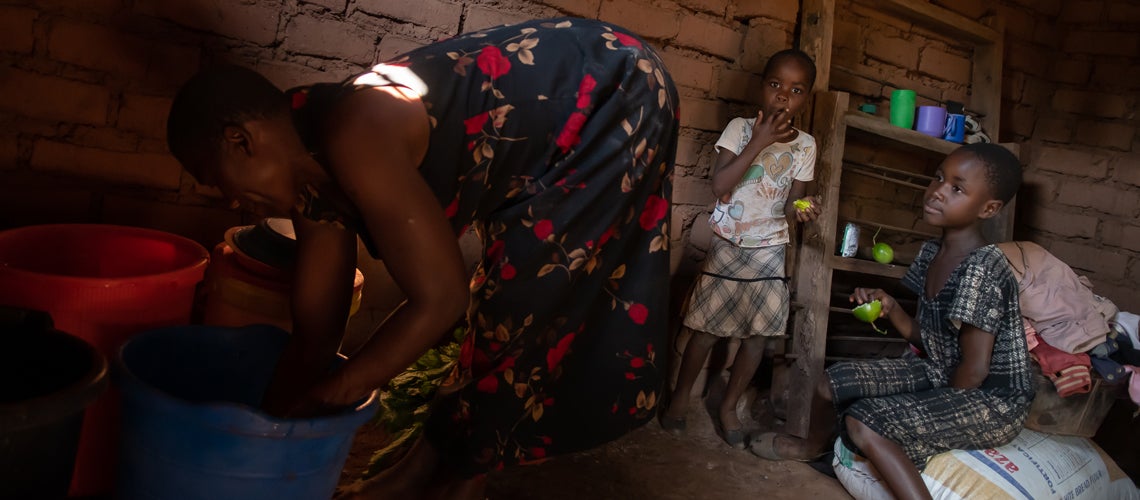 Mother with two beautiful daughters are working inside their house at a rural village in Malawi
Mother with two beautiful daughters are working inside their house at a rural village in Malawi
Between late 2015 and 2016, an unprecedented drought ravaged southern Africa. As the worst-hit country in the region, Malawi faced the largest humanitarian emergency in its history, with nearly 7 million people estimated to be unable to meet their food consumption needs. The drought came upon the heels of devastating floods in January 2015, catalyzed by the highest levels of rainfall on record in the country. Many farm households suffered severe crop losses in both periods, prompting the largest ever emergency relief operation in the country’s history.
Given the unprecedented scale of both the disasters and the aid relief efforts, we wondered in our recent paper – was the humanitarian aid getting to those people who needed it most? And once transferred, did the aid improve the welfare of the households that received it?
To answer these questions, we benefited from a multi-year, longitudinal household survey that spanned the period before and after the extreme weather shocks, namely the Malawi Integrated Household Panel Survey (IHPS). Supported by the World Bank’s Living Standards Measurement Study – Integrated Surveys on Agriculture (LSMS-ISA) initiative, the IHPS was implemented by the Malawi National Statistical Office (NSO) and is representative for all of Malawi, including urban and rural areas. Thanks to georeferenced household locations and a common administrative frame for the IHPS and administrative data on humanitarian aid distribution, we were able to link household survey data with publicly-available geospatial data on climate and the WFP-owned spatially-disaggregated time series data on humanitarian aid distribution. The interoperable data sources in turn enabled us to study the impacts of weather shocks on household welfare and the extent to which the adverse impacts were mitigated by humanitarian aid receipt.
To begin, we conducted our own objective assessment of household exposure to extreme weather events, by integrating data from the 2013 and 2016 rounds of the IHPS with geospatial data. There are several publicly-available GIS-based data sources and variables that can inform measures of droughts and floods. Our analysis suggests that the analyst’s choices related to the GIS data source and variables directly affect how we measure household exposure to droughts and floods. This is particularly significant when considering the efficacy of humanitarian aid efforts, as the geographic targeting of aid distribution was partially based on specific geospatial weather shock variables. Unfortunately, we found that the weather shock variables that explained reductions in maize yields did not explain aid distribution. Worse still, the two rainfall measures that drive aid distribution are in fact positively correlated with increased maize yields.
We found that in 2016, 19% of IHPS households that suffered a weather shock lived in areas with high poverty rates and with no or limited aid distribution. Meanwhile, 16% of IHPS households that did not suffer a weather shock lived in areas with lower poverty rates and positive aid distribution. Geographic targeting errors introduce exogenous variation aid deliveries (once long-term climate conditions are controlled for) and serve as part of our identification strategy for household aid receipt. These results suggest that the government’s reliance on certain climatic variables for targeting aid distribution led to both errors of exclusion and inclusion
With respect to household-level targeting undertaken at the community level, we find that households headed by women and those with all elderly members were more likely to receive aid, as were the poorer households. However, under a weather shock, we found that wealthier households were equally likely to receive aid, which probably reduced poorer households’ access to aid .
Turning to impact, we asked – how much did households suffer as a result of these extreme weather events, and did humanitarian aid play a role in improving household outcomes in their aftermath? We found that households that experienced one weather shock reduced non-food expenditures between 5% to 20%, but without any significant impact on their food consumption. However, our analysis suggests that households that experienced sequential shocks – both flooding and drought – suffered in terms of food consumption. Depending on the analysis sample, we found that food purchases per capita dropped by 26%, food consumption scores, a measure of dietary diversity, dropped by 12%, and the monetary value of food consumption per capita also dropped by between 14% and 20%.
Despite this dire situation, we discovered some positive benefits of aid receipt for households, particularly those who suffered from both flooding and drought. In one sample, aid led to 20% greater non-food expenditures and enabled households to maintain food purchases under sequential shocks. In another sample, aid increased the food consumption scores and school participation rates of households under sequential shocks.
At the same time, we expected that our ability to detect differences in consumption outcomes is lower when we include both relatively poor and wealthy households, since consumption forms larger share of the household budget. When we restricted our sample to only those households below median wealth, we found that aid increased the monetary value of food consumption per capita by 27% to 58% and caloric intake per capita by 42% among households that were exposed to sequential shocks.
Looking forward, we suggest that improving household targeting for humanitarian aid delivery – by revising the climatic variables used for targeting, by placing greater emphasis on sequential shocks, and by ensuring that wealth levels drive targeting decisions – would strengthen Malawi’s emergency relief operations for future disasters.




Join the Conversation